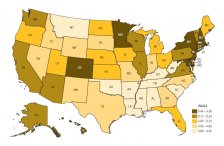The proportion of Americans with a college degree has increased steadily each year for more than a decade. According to the latest U.S. Census data, 29.6% of Americans at least 25 years old had at least a bachelor’s degree last year, up from 27.9% in 2009.
Based on recently released educational attainment data from the U.S. Census Bureau’s American Community Survey, West Virginia had the lowest level of educational attainment, with 18.9% of adults 25 and older having attained at least a bachelor’s degree in 2013. Conversely, more than 40% of Massachusetts residents had at least a bachelor’s degree, the highest percentage nationwide.
Earnings vary dramatically according to a person’s level of education. According to Holly Yettick, director of the Education Week Research Center, it is very clear that “people with higher levels of educational attainment make more money.” While a typical American adult with less than a high school diploma earned slightly more than $20, 000 in 2013, a person with a bachelor’s degree earned more than $50, 000.
Varying levels of income and poverty may also help explain the considerable variations in educational attainment between states. According to Sterling Lloyd, senior research associate at the Education Week Research Center, “varying poverty levels, or differences in socioeconomic status among residents in states” are among the major contributors to disparities in educational attainment.
In fact, the median household income in nine of the 10 states with the lowest educational attainment rates was far lower than the national median of $52, 250 in 2013. On the other end of the spectrum, the most educated states all had among the highest median household income in the nation.
A number of other factors contribute to a state’s college attainment rate. While it is extremely difficult to measure the impact of policy on a region’s level of education, Lloyd explained that policy makers expect that “efforts to increase financial assistance for students will ultimately result in higher rates of educational attainment.” State policymakers are also attempting to improve college readiness by implementing new curriculum standards and benchmarks for college readiness, Lloyd told 24/7 Wall St.
College attainment levels may also be influenced by a migration effect. Yettick pointed out that areas in Colorado, for example, have excellent college attainment rates but relatively poor high school graduation rates. This may indicate that while a state’s education system may be weak, its job market may be strong, attracting people with college degrees to move to the state.
However, a state may also attract people without college degrees. Yettick mentioned Nevada in particular, which had among the lowest college attainment. According to Yettick, “there are a lot of service jobs, so a lot of people moving into [Nevada] do not have college degrees.”











